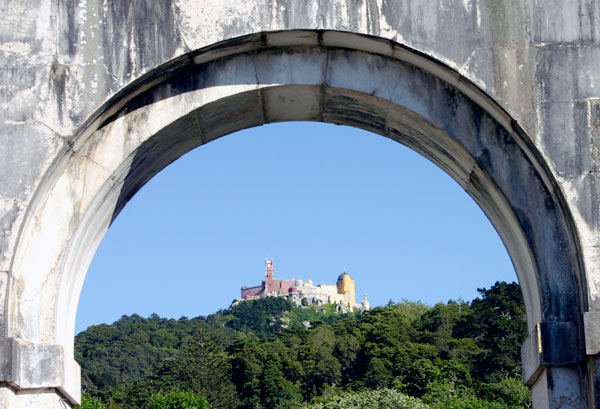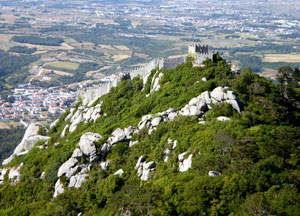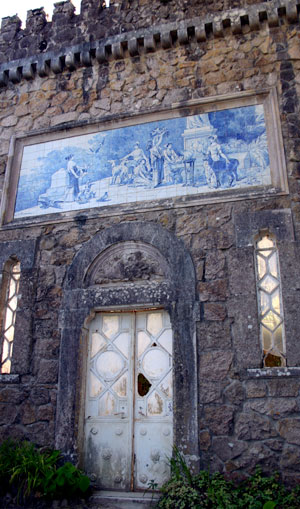SINTRA, PORTUGAL - The two horses pulling our carriage bolted after being frightened by the 100-plus horsepower car whose driver decided to serenade them with his horn.
The Portuguese reins man cursed the driver as he brought his steeds under control so we could continue our journey through the narrow streets of this enchanting ancient town that is so delightful it inspired legendary British poet Lord Byron to call it a “glorious Eden.”
Sintra, which is ringed by majestic mountains that can be seen from Lisbon, an hour’s drive away, has always enjoyed a place of honor with the Portuguese. The town is home to some of the country’s most important landmarks, most notably, a wedding cake castle called Palacio Nacional da Pena that looks Disneyesque in its appearance.
The crayon-colored castle sits perched on a hill like a crown and can be seen from most everywhere in this town that dates back to the Neolithic Age. There are so many interesting and historic things in Sintra UNESCO decided to make it a World Heritage Site a few years ago.
With the horses under control, our driver pointed out to a few of Sintra’s other attractions as we made our way to the entrance of Palacio Nacional da Pena, the last home of Portugal’s King Carlos and Queen Amelia.

Above: Not only is it historic, but Sintra is also very colourful.
We passed the town square where the much smaller national palace was first built. The grand building is ringed by chic restaurants, small shops selling reproductions of 15th century plates and a large courtyard where lovers hug on park benches under a full moon.
The interior of the castle is what you’d expect to find in a building this importance. However, the magpies painted on the lavish dining room ceiling tell a scandalous story about a former royal family who once called this home.
According to locals at the Café de Paris across the street from the palace, a king was caught kissing a lady in waiting and gossip quickly spread. Word got back to the king and he had the chatty magpies painted into the ceiling. There are as many magpies as there were ladies in waiting.


Above: Rugged terrain and ancient dwellings make Sintra special.
Another version of this tale we heard while sipping wine in Sintra was that it was the queen, not the king, who was caught kissing the the lady in waiting. Only the magpies know for sure and they’re not talking.
The carriage continued its slow trek along the main road before passing under the ornate gates of the Palacio de Seteais, a stately 18th century neo-classical building that is now home to one of Portugal’s most noted hotels, the Hotel Tivoli.
The Palacio de Seteais had been owned through the years by noble families and its location was chosen because it offers breathtaking views of the surrounding mountains and sea. The palace’s lavish gardens make you want to linger for a few hours soaking up its ambiance and scents.
Our next stop was the Quinta de Regaleira, another castle-like home built by a business man friend of the king between 1904 and 1910 – the final years of Portugal’s monarchy.
The lavish home and its amazing terraced gardens that require the stamina of a mountain climber to fully appreciate, is one of the most amazing properties you will ever see. The home comes dripping in ornate carvings, huge fireplaces; hand carved oak ceilings and lots of statues. A king would feel right at home in this house, which sits at the base of the Sintra Mountains, within walking distance of the National Palace.
A winding path takes visitors on a tour of the gardens, which consists of secret tunnels and wells and a grotto where you feel like you’re walking on water. The Viscountess da Regaleira, the man who had the house built to impress the king, wanted guests to feel the “Harmony of the Spheres.”
Back on the road, headed for the Palacio Nacional da Pena, we spotted a tram headed in the direction of our carriage and braced just in case the brightly colored train scared the horses again. The majestic beasts didn’t bat an eye as the tiny tram passed.
The red trains, which depart near Sintra’s Museum of Modern Art, follow a 10 mile path through a green landscape framed by pine trees, vineyards and platens before arriving at Sintra’s holiday beaches. The journey from the centre of town takes about 45 minutes and is worth every second, according to a local woman named Ana Sousa.
The tramway dates back to 1904 but was later derailed when the company running it collapsed. It sat idle for many years until city council decided to reopen the line to connect the main square with the beaches, according to Sousa.
It is in Sintra where Portugal drops off into the sea so the coastline here offers some of the top beaches in Europe. The best stretches of sand are the ones not far from the city centre, in an area from the Praia de Sao Juliao to the Cabo da Roca.
“Our favorite beach is Praia des Macas (Apple Beach),” the helpful Ana reported. “But please don’t tell too many people because we try to keep that beach a secret.”
The dramatic cliffs that rise from the sea in Sintra are eye candy that is sweet to look at.
The clip-clop of the horses’ hoofs against ancient cobblestones trumpeted our arrival at the entrance to Palacio Nacional da Pena.
We had to leave the carriage at that point because visitors must take a bus, or walk the winding road leading to the palace gates from that point. We decided on the bus and it turned out to be a wise decision because the road is steep and the cobblestones make it hard to walk.
It’s hard not to be impressed by the Palacio Nacional da Pena, which features a potpourri of styles, the likes of which you have never seen. King Carlos traveled a lot and incorporated many of the different architectural styles he saw and admired on his journeys. So, Arabic trefoil arches and minarets share space with Neo-Gothic elements and combine to make this one of the most unique structures in the world. Portuguese style is represented in the impressive tiles that cover many of the palace’s interior and exterior walls.
Just like the exterior, the palaces’ interior showcases a number of different styles and materials. Almost all the original contents of the palace have been preserved so visitors get to see first hand the luxury trappings the monarchy once enjoyed. The most remarkable room in the palace is the chapel, whose alter is decorated with alabaster and black marble. It was created by Nicolau Chanterene in 1532 and is decorated with images of the Holy Family and biblical scenes.
The Salao Nobre is the most opulent room in the palace – its stuccowork of Arabic and plant motifs, German stained-glass windows, Neo-gothic chandelier, four wooden Turkish sculptors, 19th century sideboards and Carlos X vase give this room a museum look about it.
The palace’s inner courtyard was the place the royal family would like to linger while reading Lord Byron’s works. The British poet was a regular visitor to Sintra and the area inspired many of his great works.
A narrow ledge running along the castle wall looks out on the breathtaking countryside and down on a Moorish castle, just another of the town’s remarkable highlights. The Arab military fortress was constructed in the 8th century and was the town icon until the Palacio Nacional da Pena was built.
Other important monuments that will amaze you in Sintra are the Torre do Relogo (clock tower), the Sao Martinho Church, the Paco dos Ribafria, the Trindade Convent, the Santa Maria Church and an impressive grouping of fountains.
The streets of Sintra are narrow and steep and fun to explore. Most lead to the Café de Paris where they serve up wholesome dishes like fish soup and fillet of pork in a port reduction. From the restaurant’s outdoor terrace you can watch the moon hang over the Moorish castle ruins.
It will be just one of the magical moments you’ll enjoy while visiting Sintra.
Information
A highly recommended accommodation for those traveling to Sintra is the Penha Longa Hotel and Golf Resort, a Ritz property that is an historic site in its own right. For information, go to
www.penhalonga.com.